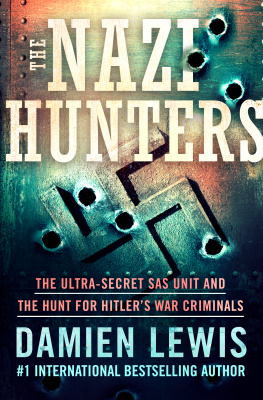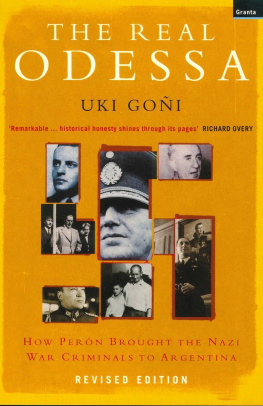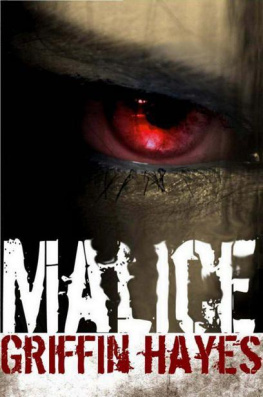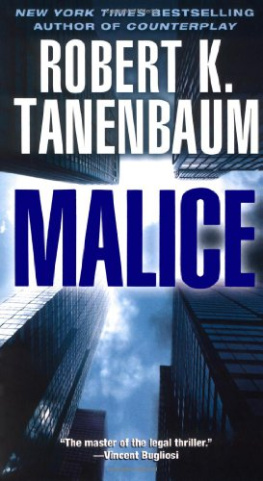Joel E. Dimsdale - Anatomy of Malice: The Enigma of the Nazi War Criminals
Here you can read online Joel E. Dimsdale - Anatomy of Malice: The Enigma of the Nazi War Criminals full text of the book (entire story) in english for free. Download pdf and epub, get meaning, cover and reviews about this ebook. year: 2016, publisher: Yale University Press (Ignition), genre: History. Description of the work, (preface) as well as reviews are available. Best literature library LitArk.com created for fans of good reading and offers a wide selection of genres:
Romance novel
Science fiction
Adventure
Detective
Science
History
Home and family
Prose
Art
Politics
Computer
Non-fiction
Religion
Business
Children
Humor
Choose a favorite category and find really read worthwhile books. Enjoy immersion in the world of imagination, feel the emotions of the characters or learn something new for yourself, make an fascinating discovery.

- Book:Anatomy of Malice: The Enigma of the Nazi War Criminals
- Author:
- Publisher:Yale University Press (Ignition)
- Genre:
- Year:2016
- Rating:4 / 5
- Favourites:Add to favourites
- Your mark:
- 80
- 1
- 2
- 3
- 4
- 5
Anatomy of Malice: The Enigma of the Nazi War Criminals: summary, description and annotation
We offer to read an annotation, description, summary or preface (depends on what the author of the book "Anatomy of Malice: The Enigma of the Nazi War Criminals" wrote himself). If you haven't found the necessary information about the book — write in the comments, we will try to find it.
Anatomy of Malice: The Enigma of the Nazi War Criminals — read online for free the complete book (whole text) full work
Below is the text of the book, divided by pages. System saving the place of the last page read, allows you to conveniently read the book "Anatomy of Malice: The Enigma of the Nazi War Criminals" online for free, without having to search again every time where you left off. Put a bookmark, and you can go to the page where you finished reading at any time.
Font size:
Interval:
Bookmark:
ANATOMY OF MALICE
JOEL E. DIMSDALE
Anatomy of Malice
THE ENIGMA OF THE NAZI WAR CRIMINALS
Yale
UNIVERSITY PRESS
NEW HAVEN & LONDON
Copyright 2016 by Yale University.
All rights reserved.
This book may not be reproduced, in whole or in part, including illustrations, in any form (beyond that copying permitted by Sections 107 and 108 of the US Copyright Law and except by reviewers for the public press), without written permission from the publishers.
Excerpts from Nuremberg Diary copyright 08-22-1995 books-contributor-g-20m-20gilbert.
Reprinted by permission of da capo, a member of the Perseus Books Group.
Yale University Press books may be purchased in quantity for educational, business, or promotional use. For information, please e-mail (UK office).
Additional information, including references, links, and discussion guide, is available at www.anatomyofmalice.com
Set in Scala type by Newgen North America.
Printed in the United States of America.
Library of Congress Control Number: 2016930154
ISBN 978-0-300-21322-5 (hardcover)
A catalogue record for this book is available from the British Library.
This paper meets the requirements of ANSI/NISO Z39.481992 (Permanence of Paper).
10 9 8 7 6 5 4 3 2 1
CONTENTS
PREFACE
Beginnings in a Land of Manure and Blood
WHEN THE WIND BLOWS FROM THE EAST, there is a gentle wafting of manure and blood that settles over Sioux City, Iowa. It is not unpleasant, and it reminds one of the agricultural richness of the area. Growing up there in the 1940s and 1950s was about the most secure environment imaginable, tucked away in the vastness and fastness of America, surrounded by thousands of square miles of prairie and Great Plains and remote from threatening borders.
And yet, there were shadows. William Faulkner said, The past is never dead; the past is not even past. Sioux City became home to many concentration camp survivors, attracted there by its beautiful, gentle rolling hills, its agricultural richness, and its isolation from a world they knew, a world that was in no way secure. My brother saw it first as a ten-year-old boy, when he was on his paper route, and glimpsed a tattoo on the forearm of a neighbor. The neighbor, it seems, was embarrassed by this revelation, and my brother didnt know what it meant. My mother, usually at no loss for words, was uneasy and sparing in her explanation.
I think I must have been six or seven when I learned what shadows haunted our neighbors. I was on an after-dinner walk with my dad, who was a local doctor. It was March or April, and the ground in the neighboring park was soft from the melting snows and the land smelled fresh. It was Passover, and my father was upset about a house call he had made that week. One of his patients had developed severe angina. That in itself was not enough to upset my dad. He took care of everybody and was accustomed to death. What was different for this patient was the timing of his illness. He was a concentration camp survivor who had witnessed the murder of his entire family on Passover in another land of rolling hills, blood, and manure. His religion told him to rejoice in his liberation on Passover; he knew better.
In those days before Adolf Eichmann was captured, people preferred not to know about the Holocaust. Robert Jay Lifton famously remarked in Death in Life: Survivors of Hiroshima (1968) that survivors of massive trauma typically elicit a fear of contagion from the people they meet subsequently. Still, it was hard for me to dismiss the Holocaust, since in small towns, one is privy to many secrets and ghosts.
As a little boy, I hadnt thought much about evil. Television was still new, the programing scanty, and the news lasted only fifteen minutes. I grew up with stick-finger thin ideas of evil from the comic booksthe Joker, Lex Luther, Doctor Doom. This was not a world where evil was nuanced. Instead, it was the other, demonic, and utterly different from the citizens and the heroes of the comic strip. Thus, it comes as no surprise that Ilike most people in the 1940s and 1950sthought that the Nazis who designed and ran the concentration camps were depraved and utterly foreign to human nature.
The Executioner in my Office
Years passed. After college, I joined an archaeological expedition, digging far below the surface of the twentieth century and sorrowfully unearthing layers of ashes that indicated other violence, millennia before. I went to graduate school in sociology to learn more about how social forces shape our lives and went to medical school to learn how to heal people.
I probably would have left the Holocaust behind had I not received a call from one of my parents friends, inviting me to dinner to celebrate my beginning medical school. She took me to one of Sioux Citys old family-run restaurants andover a midwestern comfort-food kind of dinner with caramel sweet rolls as a starter, meat loaf, baked potatoes, overcooked string beans, and Folgers coffeeshe told me about her life in the concentration camps. She said that she hadnt talked about it before but she was getting old and wanted someone to know. She too had lost her entire family in the war but had built a new life in Iowa that seemed so utterly normal except for the nightmares that haunted her every night. We talked for hours, and the restaurants celebrated caramel sweet rolls didnt rest easy on my stomach that night.
With my interests in history and social forces, it was no surprise that I eventually became a psychiatrist, nor was it a surprise that I started studying concentration camp survivors to learn how they coped with their imprisonment and survival. In 1974, I published an article on the coping behavior of Nazi concentration camp survivors. The article briefly captured the interest of local media, and the news coverage resulted in an encounter that shaped my subsequent research interests.
I was in my office in the attic of a little isolated building on the Massachusetts General Hospital grounds. There was a loud knock on my door, and I was startled because I wasnt expecting anyone and the building had few visitors. A stocky man walked in, saying without any preamble, I am the executioner and I have come for you. He sat down on my sofa, gestured to a gun case, and I said a quiet little prayer to myself. When he opened the case, I saw that it was not a gun case after all but rather a document case with scrolls of World War II documents. I was the Nuremberg executioner and these documents prove that I am who I say I am. He went on to tell me that he was proud of his job and that while still being professional about it, he enjoyed hanging the criminals. They were scum, Dimsdale, and you need to be studying them, not the survivors.
Chance Meetings
One doesnt forget such an encounter. I didnt act on it, but it lurked there in the back of my mind. Then, another chance meeting happened. I was at a dinner party in Gainesville, Florida, where I met the renowned Rorschach expert Molly Harrower. It was Molly who told me the story of the Rorschach testing of the Nuremberg war criminals and the mystery and controversy that to this day swirls around this topic.
This book tells a dark story that stretches from Germany to Switzerland and, oddly, from New Jersey to California. I didnt rush to write this book; I didnt want to. It was just too dark, but the story kept haunting me, and as I got older, I couldnt fend it off any longer. So, this book traces the legacy of Nuremberg and what I have come to learn about evil, what I have called the anatomy of malice.
THE PROTAGONISTS
Burton C. Andrus, warden of Ashcan and Nuremberg
Gustave Gilbert, American psychologist
Hermann Gring, Reichsmarshall, head of the Luftwaffe
Next pageFont size:
Interval:
Bookmark:
Similar books «Anatomy of Malice: The Enigma of the Nazi War Criminals»
Look at similar books to Anatomy of Malice: The Enigma of the Nazi War Criminals. We have selected literature similar in name and meaning in the hope of providing readers with more options to find new, interesting, not yet read works.
Discussion, reviews of the book Anatomy of Malice: The Enigma of the Nazi War Criminals and just readers' own opinions. Leave your comments, write what you think about the work, its meaning or the main characters. Specify what exactly you liked and what you didn't like, and why you think so.






